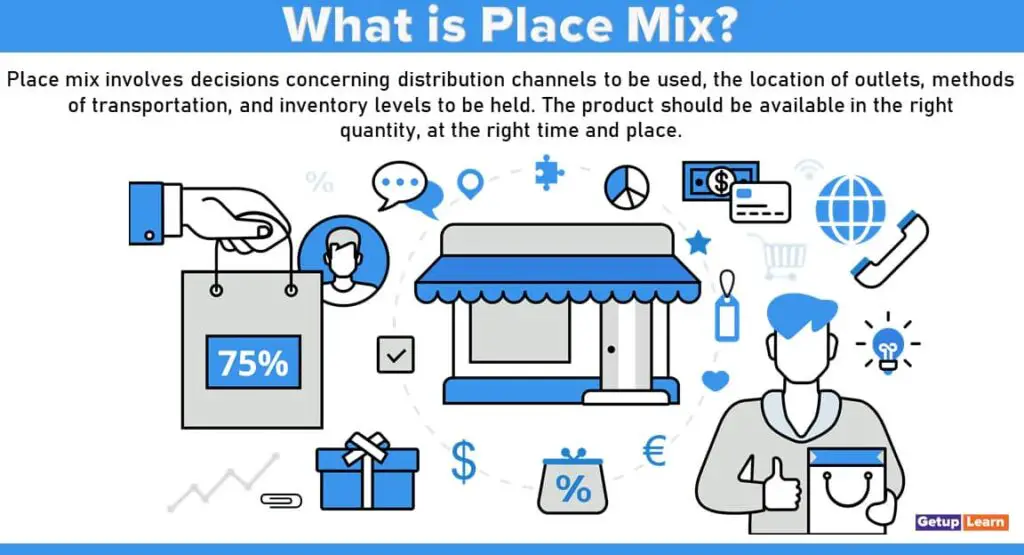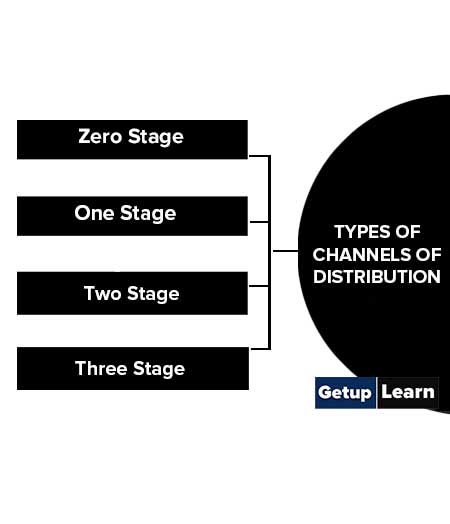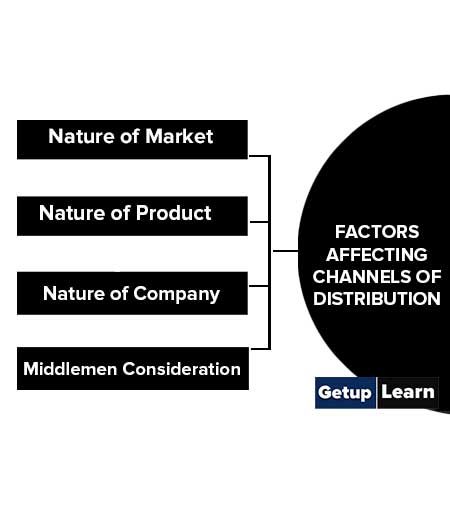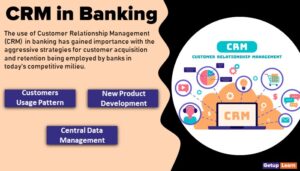Table of Contents
What is Place Mix?
Place mix involves decisions concerning distribution channels to be used, the location of outlets, methods of transportation, and inventory levels to be held. The product should be available in the right quantity, at the right time and place.
Distribution channels consist of independent intermediaries such as retailers, wholesalers, and distributors through which goods pass on their way to customers.

These intermediaries provide cost-effective access to the marketplace. It will be extremely expensive and cumbersome if the manufacturer had to set up the entire infrastructure needed to manage the transfer of goods to the customer. Three distinct functions are performed by distribution channels.
They transfer products from the manufacturer to the customers, they pass information from the manufacturer to the customer and they retrieve payments from the customers to the manufacturer. The three functions are important but it is not essential that all three functions need to be performed by any one channel.
There can be three separate channels that can perform each function individually, depending on the efficiency and effectiveness of each channel in carrying out the functions.
Read Also: What is Marketing Mix?
A marketing Mix is a particular combination of the product, its price, the methods to promote it, and the ways to make the product available to the customer. Based upon its understanding of customers, a company develops its marketing mix of product, place, price, and promotion.
Channels of Distribution
You are aware that while a manufacturer of a product is located in one place, its consumers are located in innumerable places spread all over the country or the world. The manufacturer has to ensure the availability of his goods to the consumers at convenient points for their purchase.
He may do so directly or, as stated earlier, through a chain of middlemen like distributors, wholesalers, and retailers. The path or route adopted by him for the purpose is known as a channel of distribution.
A channel of distribution thus, refers to the pathway used by the manufacturer for transfer of the ownership of goods and its physical transfer to the consumers and the user/buyers (industrial buyers).
Stanton has also defined it as “A distribution channel consisting of the set of people and firms involved in the transfer of title to a product as the product moves from producer to ultimate consumer or business user”.
Basically, it refers to the vital links connecting the manufacturers and producers and the ultimate consumers/users. It includes both the producer and the end user and also the middlemen/agents engaged in the process of transfer the of title of goods.
Functions of Distribution Channel
These are the primary functions of distribution channel:
- It helps in establishing regular contact with the customers and provides them with the necessary information relating to the goods.
- It provides the facility for inspection of goods by the consumers at convenient points to make their choice.
- It facilitates the transfer of ownership as well as the delivery of goods.
- It helps in financing by giving credit facilities.
- It assists the provision of after-sales services, if necessary.
- It assumes all risks connected with carrying out the distribution function.
Types of Channels of Distribution
Generally, we do not buy goods directly from the producers. The producers/ manufacturers usually use the services of one or more middlemen to supply their goods to the consumers. But sometimes, they do have direct contact with the customers with no middlemen in between them. This is true more for industrial goods where the customers are highly knowledgeable and their individual purchases are large.
These are the types of channels of distribution that explain below:
- Zero Stage Channel of Distribution
- One Stage Channel of Distribution
- Two Stage Channel of Distribution
- Three Stage Channel of Distribution

Zero Stage Channel of Distribution
Zero stage distribution channel exists where there is a direct sale of goods by the producer to the consumer. This direct contact with the consumer can be made through door-to-door salesmen, own retail outlets or even through direct mail.
Also in case of perishable products and certain technical household products, door-to-door sale is an easier way of convincing consumer to make a purchase. Eureka Forbes, for example, sells its water purifiers directly through their own sales staff.

One Stage Channel of Distribution
In this case, there is one middleman i.e., the retailer. The manufacturers sell their goods to retailers who in turn sell them to the consumers. This type of distribution channel is preferred by manufacturers of consumer durables like refrigerators, air conditioners, washing machines, etc.
Where individual purchase involves a large amount. It is also used for distribution through large-scale retailers such as departmental stores (Big Bazaar, Sponsors) and supermarkets.

Two Stage Channel of Distribution
This is the most commonly used channel of distribution for the sale of consumer goods. In this case, there are two middlemen used, namely, the wholesaler and retailer. This is applicable to products where markets are spread over a large area, the value of the individual purchase is small and the frequency of purchase is high.

Three Stage Channel of Distribution
When the number of wholesalers used is large and they are scattered throughout the country, the manufacturers often use the services of mercantile agents who act as a link between the producer and the wholesaler. They are also known as distributors.

Factors Affecting Channels of Distribution
Factors Affecting the Choice of Distribution Channel:
The choice of an appropriate distribution channel is very important as the pricing as well as promotion strategy are dependent upon the distribution channel selected. Not only that, the route that the product follows in its journey from the manufacturer to the consumer also involves certain costs.
This, in turn, affects not only the price of the product but also the profits. The choice of inappropriate channels of distribution may result in lesser profits for the manufacturer and higher prices for the consumer.
Hence, the manufacturer has to be careful while finalizing the channel of distribution to be used. Following are the factors affecting channels of distribution:

Nature of Market
There are many aspects of the market which determine the choice of channel of distribution. Say for example, where the number of buyers is limited, they are concentrated at few locations and their individual purchases are large as is the case with industrial buyers, direct sale may be the most preferred choice.
But in cases where the number of buyers is large with the small individual purchases and they are scattered, then a need may arise for use of middlemen.
Nature of Product
The nature of the product considerably affects the choice of channel of distribution. In case the product is of technical nature involving a good amount of pre-sale and after-sale services, the sale is generally done through retailers without involving the wholesalers.
But in most of the consumer goods having small value, bought frequently in small quantities, a long channel involving agents, wholesalers and retailers is used as the goods need to be stored at convenient locations. Items like toiletries, groceries, etc. fall in this category.
As against this in the case of items like industrial machinery, having large value and involving specialized technical service and a long negotiation period, a direct sale is preferred.
Nature of Company
A firm having enough financial resources can afford to have its own distribution force and retail outlet,. But most business firms prefer not to create their own distribution channel and concentrate on manufacturing. The firms who wish to control the distribution network prefer a shorter channel.
Middlemen Consideration
If the right kind of middlemen having the necessary experience, contacts, financial strength, and integrity are available, their use is preferred as they can ensure the success of newly introduced products.
Cost factors also have to be kept in view as all middlemen add their own margin of profit to the price of the products. But from experience, it is learned that where the volume of sales is adequate, the use of middlemen is often found economical and less cumbersome than direct sales.
What is the meaning of place mix?
Place mix refers to the place where the customers can buy the product and how the product reaches out to that place. This is done through different channels like: Retails, Wholesale, Internet, Mail Orders, Direct Sales, etc.
What are the types of channels of distribution?
Types of channels of distribution are given below:
1. Zero Stage Channel of Distribution
2. One Stage Channel of Distribution
3. Two Stage Channel of Distribution
4. Three Stage Channel of Distribution.
What are the factors affecting channels of distribution?
Factors affecting channels of distribution:
1. Nature of Market
2. Nature of Product
3. Nature of Company
4. Middlemen Consideration.













